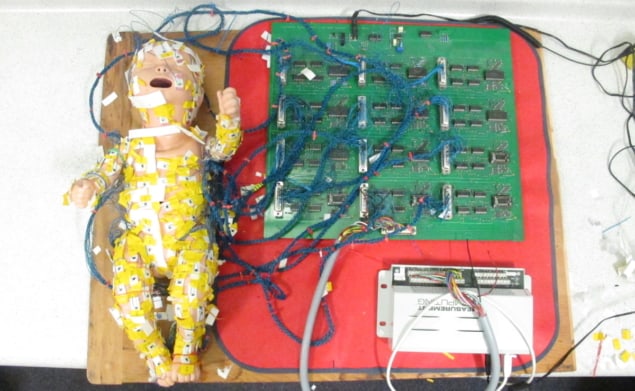
Neonatal jaundice is a common condition in newborn babies, caused by the build-up of bilirubin in the blood. While the majority of babies will recover naturally, if extremely high blood bilirubin levels are left untreated, there’s a small risk that the bilirubin could pass into the brain and cause brain damage. Such cases are usually treated using phototherapy, in which blue light shone onto the skin reduces the bilirubin values to safer levels.
Phototherapy is delivered using overhead lamps or blanket-style illumination devices. Previous studies, however, revealed that many such phototherapy devices fail to deliver the recommended irradiance levels. Now, researchers at University Hospital Coventry have developed the first system that can measure the integrated dose rate of light delivered to a neonate body shape. They describe their approach in Medical Engineering & Physics.
Detection array
Phototherapy devices are typically evaluated by measuring peak irradiance levels at various locations over a neonate’s body surface. But this approach cannot estimate the total rate of energy delivery within a specific spectral range over the entire exposed body surface.
“The integrated dose rate is the parameter that gives the best indication if phototherapy is likely to be appropriate,” explains first author Douglas Clarkson. “A single local intensity value can be misleading if the ‘light field’ size is small relative to the size of the neonate.”
To determine the integrated dose rate delivered by a phototherapy device within a selected wavelength interval, Clarkson and colleagues used an array of 192 blue-wavelength-enhanced silicon photodiodes to measure the dose contributions over the surface of a neonate body shape.
As the physical model for their experiments, the researchers used a body shape based on the SimNewB simulator device, which has a shape that closely corresponds to a term neonate of average weight and height. They divided the surface into 12 anatomical regions and attached 16 calibrated photodiodes to each region. They then used this setup to estimate the dose contributions by anatomical region, in the spectral range 460–490 nm, for three neonatal phototherapy devices: Natus neoBlue; GE Medical BiliSoft blanket; and GE Medical Giraffe Spot.
As expected, the BiliSoft blanket delivered the majority of output to the rear torso, although the team noted a significant difference between dose to the right and left sides. The Giraffe Spot unit delivered light centred on the naval, with relatively little dose to the arms, legs and head. The Natus neoBlue delivered a more extensive light field, with the arms, legs and upper torso all receiving useful dose contributions.
The measurements revealed significant differences in delivered levels of phototherapy, which would likely also lead to differences in the relative clinical effectiveness of each phototherapy system.
Clinical impact
The reduction in serum bilirubin during treatment is a key parameter indicating the effectiveness of neonatal phototherapy. The test system’s ability to measure the dose rate within specific spectral bands enables the creation of a model relating the rate of energy delivery to the neonate to the rate of bilirubin decrease during treatment.
“Newborns get into a bilirubin imbalance due to breakdown of haemoglobin. It is important that the phototherapy dose rate is sufficiently high to counteract this factor and act to decrease it to safe levels,” says Clarkson, noting that the important clinical focus for this work was provided by consultant neonatologist Prakash Satodia at University Hospital Coventry.
The team also suggest that the technology could help develop a revised medical device equipment standard that allows determination of output power delivery within designated wavelength intervals for a specific neonate baby shape.
The researchers conclude that their system provides the “missing link” in determining the relative effectiveness of neonatal phototherapy lamps and optimizing clinical phototherapy. To provide a more practical measurement device, particularly for premature infant body shapes that would be challenging to cover in photodiodes, they are developing a modified design based on wrap-round thin-film photovoltaic technology.
Clarkson is also creating an interactive software tool to optimize phototherapy based on dose rates delivered within specific wavelength intervals. “It is hoped that this type of software, while having a research focus at this stage, will filter into clinical use as the best way to manage neonatal phototherapy,” he tells Physics World.



